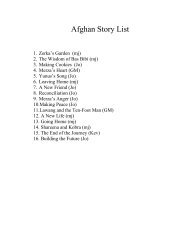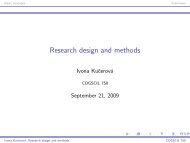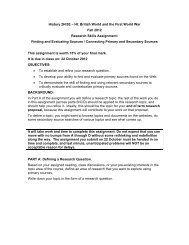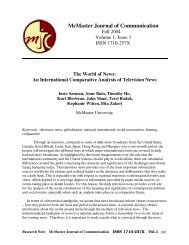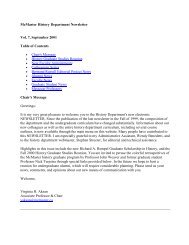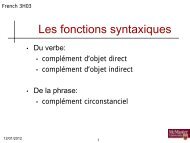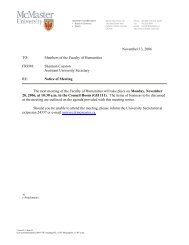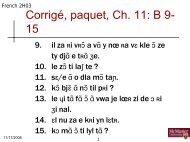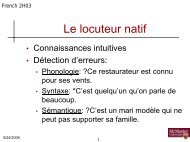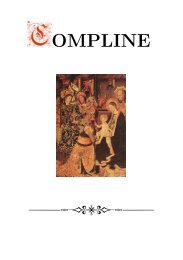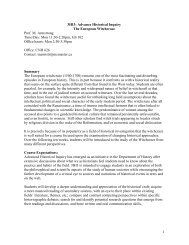Age-of-acquisition ratings for 30 thousand English words - Center for ...
Age-of-acquisition ratings for 30 thousand English words - Center for ...
Age-of-acquisition ratings for 30 thousand English words - Center for ...
You also want an ePaper? Increase the reach of your titles
YUMPU automatically turns print PDFs into web optimized ePapers that Google loves.
<strong>Age</strong>-<strong>of</strong>-<strong>acquisition</strong> <strong>ratings</strong><br />
<strong>for</strong> <strong>30</strong> <strong>thousand</strong> <strong>English</strong> <strong>words</strong><br />
Victor Kuperman 1 Hans Stadthagen-Gonzalez 2 Marc Brysbaert 3<br />
1 McMaster University, Canada<br />
2 Bangor University, UK<br />
3 Ghent University, Belgium<br />
Key<strong>words</strong>: word recognition, age-<strong>of</strong>-<strong>acquisition</strong>, <strong>ratings</strong>, Amazon Mechanical Turk<br />
Corresponding author:<br />
Victor Kuperman, Ph.D.<br />
Department <strong>of</strong> Linguistics and Languages, McMaster University<br />
Togo Salmon Hall 626<br />
1280 Main Street West<br />
Hamilton, Ontario, Canada L8S 4M2<br />
phone: 905-525-9140, x. 20384<br />
vickup@mcmaster.ca<br />
1
Abstract<br />
We present age-<strong>of</strong>-<strong>acquisition</strong> (AoA) <strong>ratings</strong> <strong>for</strong> <strong>30</strong>,121 <strong>English</strong> content <strong>words</strong> (nouns, verbs,<br />
and adjectives). For data collection, this mega-study used the web-based crowdsourcing<br />
technology <strong>of</strong>fered by the Amazon Mechanical Turk. Our data indicate that the <strong>ratings</strong> collected<br />
in this way are as valid and reliable as those collected in laboratory conditions (the correlation<br />
between our <strong>ratings</strong> and those collected in the lab from US students reached 0.93 <strong>for</strong> a subsample<br />
<strong>of</strong> 2,500 monosyllabic <strong>words</strong>). We also show that our AoA <strong>ratings</strong> explain a substantial<br />
percentage <strong>of</strong> variance in the lexical decision data <strong>of</strong> the <strong>English</strong> Lexicon Project over and above<br />
the effects <strong>of</strong> log frequency, word length, and similarity to other <strong>words</strong>. This is true not only <strong>for</strong><br />
the lemmas used in our rating study, but also <strong>for</strong> their inflected <strong>for</strong>ms. We further discuss the<br />
relationships <strong>of</strong> AoA with other predictors <strong>of</strong> word recognition and illustrate the utility <strong>of</strong> AoA<br />
<strong>ratings</strong> <strong>for</strong> research on vocabulary growth.<br />
2
<strong>Age</strong>-<strong>of</strong>-<strong>acquisition</strong> <strong>ratings</strong> <strong>for</strong> <strong>30</strong> <strong>thousand</strong> <strong>English</strong> <strong>words</strong><br />
Researchers using <strong>words</strong> as stimulus materials typically control or manipulate their stimuli on a<br />
number <strong>of</strong> variables. The four that are most commonly used are: word frequency, word length,<br />
similarity to other <strong>words</strong> and word onset. In this paper we will argue that age-<strong>of</strong>-<strong>acquisition</strong><br />
(AoA) should be part <strong>of</strong> this list and we provide <strong>ratings</strong> <strong>for</strong> a substantial number <strong>of</strong> <strong>words</strong> to do<br />
so. First, however, we discuss the evidence in favor <strong>of</strong> the big four.<br />
Word frequency is the most influential variable to take into account, certainly when lexical<br />
decision is the task in question (Balota, Cortese, Sergent-Marshall, Spieler, & Yap, 2004;<br />
Ferrand, Brysbaert, Keuleers, New, Bonin, Meot, Augustinova, & Pallier, 2011). If the frequency<br />
measure comes from an adequate corpus, the percentage <strong>of</strong> variance explained by this variable in<br />
lexical decision times easily exceeds <strong>30</strong>% (Brysbaert & New, 2009; Ferrand, New, Brysbaert,<br />
Keuleers, Bonin, Méot, Augustinova, & Pallier, 2010; Keuleers, Diependaele, & Brysbaert,<br />
2010; Keuleers, Lacey, Rastle, & Brysbaert, 2012).<br />
Word length – measured either in characters or in syllables – is an important variable in word<br />
naming and progressive demasking (Ferrand et al., 2011) and also in lexical decision. In general,<br />
word processing time increases the more letters a <strong>words</strong> contains, although in lexical decision the<br />
effect seems to be curvilinear rather than linear, as it is not observed <strong>for</strong> short <strong>words</strong> (Ferrand et<br />
al. 2010; New, Ferrand, Pallier, & Brysbaert, 2006). Additional syllables induce a processing<br />
cost as well (Ferrand et al., 2011; Fitzsimmons & Drieghe, 2011; New et al., 2006).<br />
The similarity <strong>of</strong> a word to other <strong>words</strong> has traditionally been measured with bigram<br />
frequency or Coltheart’s N. Bigram frequency refers to the average frequency <strong>of</strong> the letter pairs<br />
3
in the word. Coltheart’s N refers to the number <strong>of</strong> <strong>words</strong> that can be <strong>for</strong>med by changing one<br />
letter in the word. These are so-called word neighbors (e.g., “dark”, “lurk”, and “lard” are<br />
neighbors <strong>of</strong> the word “lark”). Yarkoni, Balota, and Yap (2008), however, introduced a measure,<br />
OLD20, that captures more variance in lexical decision times (Ferrand et al., 2010, 2011) and<br />
naming latencies (Yarkoni et al., 2008). OLD20 is a measure <strong>of</strong> orthographic similarity and<br />
calculates the minimum number <strong>of</strong> letter changes needed to trans<strong>for</strong>m the target word into 20<br />
other <strong>words</strong>. For instance, the OLD20 value <strong>of</strong> 1 means that 20 <strong>words</strong> can be <strong>for</strong>med from the<br />
target word by either adding, deleting or changing one <strong>of</strong> the word’s letters.<br />
Finally, the quality <strong>of</strong> the first phoneme <strong>of</strong> a word, or its place/manner <strong>of</strong> articulation, is the<br />
most influential variable in word naming (Balota et al., 2004; Yap & Balota, 2009) and auditory<br />
lexical decision (Yap & Brysbaert, 2009). The first letter(s) also play an important role in<br />
progressive demasking (Ferrand et al., 2011).<br />
Brysbaert, Buchmeier, Conrad, Jacobs, Bölte, and Böhl (2011) ran a stepwise regression<br />
analysis on the lexical decision times <strong>of</strong> the <strong>English</strong> Lexicon Project (Balota, Yap, Cortese,<br />
Hutchison, Kessler, L<strong>of</strong>tis, Neely, Nelson, Simpson, & Treiman, 2007). In this project lexical<br />
decision and word naming times <strong>for</strong> over 40 <strong>thousand</strong> <strong>English</strong> <strong>words</strong> were collected. In addition,<br />
in<strong>for</strong>mation about 20 word variables has been made available, including:<br />
• Frequency<br />
• Orthographic length <strong>of</strong> the word (number <strong>of</strong> letters)<br />
• Number <strong>of</strong> orthographic, phonological, and phonographic neighbors (i.e., the number<br />
<strong>of</strong> <strong>words</strong> that differ in one letter or phoneme from the target word, either with or<br />
4
without the exclusion <strong>of</strong> homophones), both unweighted or weighted <strong>for</strong> word<br />
frequency<br />
• Orthographic and phonological distance to the 20 closest <strong>words</strong> (OLD20 and<br />
PLD20);<br />
• The mean and sum <strong>of</strong> the bigram frequencies (i.e., the number <strong>of</strong> <strong>words</strong> containing<br />
the letter pairs within the target word); either based on the total number <strong>of</strong> <strong>words</strong> or<br />
limited to the syntactic class <strong>of</strong> the target word<br />
• The number <strong>of</strong> phonemes and syllables <strong>of</strong> the word<br />
• The number <strong>of</strong> morphemes in the word<br />
When all variables were entered in Brysbaert et al.’s (2011) stepwise multiple regression<br />
analysis, the most important variable to predict lexical decision time was word frequency,<br />
accounting <strong>for</strong> 40.5% <strong>of</strong> the variance. The second most important variable was OLD20, which<br />
accounted <strong>for</strong> additional 12.9% <strong>of</strong> variance. The unique contribution <strong>of</strong> the third variable, the<br />
number <strong>of</strong> syllables, dropped to 1.2%, and the summed contribution <strong>of</strong> the remaining variables<br />
amounted to a mere 2.0% (Brysbaert et al., 2011). Other authors also reported that the percentage<br />
<strong>of</strong> variance explained by new variables usually is less than 1% once the big four are partialled<br />
out (e.g., Baayen, Feldman, Schreuder, 2006; Juhasz, Yap, Dicke, Taylor, & Gullick, 2011).<br />
A promising variable to add to the big four is age-<strong>of</strong>-<strong>acquisition</strong> (AoA) or the age at which a<br />
word was learned (<strong>for</strong> reviews, see Brysbaert & Ghyselinck, 2006; Ghyselinck, Lewis,<br />
Brysbaert, 2004; Johnston & Barry, 2006; Juhasz, 2005). Several studies have attested to the<br />
importance <strong>of</strong> this variable. For instance, Brysbaert and Cortese (2011) reported that it explained<br />
up to 5% more variance in lexical decision times <strong>of</strong> <strong>English</strong> monosyllabic <strong>words</strong> in addition to<br />
5
the best word frequency measure available (also see Juhasz et al., 2011). A similar conclusion<br />
was reached by Ferrand et al. (2011) <strong>for</strong> monosyllabic <strong>words</strong> in French.<br />
Two reasons have been proposed <strong>for</strong> the importance <strong>of</strong> AoA in word recognition. The first is<br />
that word frequency measures as currently collected do not fully match the cumulative frequency<br />
with which participants have been exposed to <strong>words</strong> (Bonin, Barry, Meot, & Chalard, 2004;<br />
Zevin & Seidenberg, 2002; but see Perez, 2007). Because word frequency estimates are mostly<br />
based on materials produced <strong>for</strong> adult readers, they underestimate the frequency <strong>of</strong> <strong>words</strong><br />
typically used in childhood. The second reason <strong>for</strong> an important contribution <strong>of</strong> AoA is that the<br />
order in which <strong>words</strong> are learned influences the speed with which their representations can be<br />
activated, independently <strong>of</strong> the total number <strong>of</strong> times they have been encountered. Words learned<br />
first are easier to access than <strong>words</strong> learned later (Izura, Perez, Agallou, Wright, Marin,<br />
Stadthagen-Gonzalez, & Ellis, 2011; Monaghan & Ellis, 2010; Stadthagen-Gonzalez, Bowers, &<br />
Damian, 2004), possibly because their meaning is more accessible (Brysbaert, Van Wijnendaele,<br />
& De Deyne, 2000; Sailor, Zimmerman, & Sanders, 2011; Steyvers & Tenenbaum, 2005).<br />
Un<strong>for</strong>tunately, in many experiments AoA cannot be controlled because the measure only<br />
exists <strong>for</strong> a small percentage <strong>of</strong> <strong>words</strong>. AoA estimates are typically obtained by asking a group <strong>of</strong><br />
participants to indicate at which age they learned various <strong>words</strong>. Because gathering such <strong>ratings</strong><br />
is time-consuming, they are limited in number relative to the total possible range <strong>of</strong> stimuli. A<br />
major step <strong>for</strong>ward was realized in <strong>English</strong>, when Cortese and Khanna (2008) published AoA<br />
<strong>ratings</strong> <strong>for</strong> 3,000 monosyllabic <strong>words</strong>, making it possible to include the variable in most<br />
subsequent analyses <strong>of</strong> these <strong>words</strong> (e.g., Brysbaert & Cortese, 2011; Juhasz et al., 2011). A<br />
similar investment was made in French (see Ferrand et al., 2011).<br />
6
Still, three <strong>thousand</strong> <strong>words</strong> is a limited number if one aims to analyze the data <strong>of</strong> megastudies<br />
such as the <strong>English</strong> Lexicon Project (40 <strong>thousand</strong> <strong>words</strong>; Balota et al., 2007) or the<br />
British Lexicon Project (28 <strong>thousand</strong> mono- and disyllabic <strong>words</strong>; Keuleers et al., 2012). The<br />
number <strong>of</strong> available AoA <strong>ratings</strong> in <strong>English</strong> can be doubled to 6,000 if the <strong>ratings</strong> <strong>of</strong> Cortese and<br />
Khanna (2008) are combined with those <strong>of</strong> Gilhooly and Logie (1980), Bird, Franklin, and<br />
Howard (2001), and Stadthagen-Gonzalez and Davis (2006). However, this still imposes serious<br />
constraints on stimulus selection <strong>for</strong> typical experiments.<br />
Recent developments in techniques <strong>of</strong> linguistic data collection may alleviate the situation,<br />
however. In particular, the crowdsourcing technology <strong>of</strong> Amazon Mechanical Turk as an internet<br />
market place has provided language researchers with an attractive new tool. Amazon Mechanical<br />
Turk (https://www.mturk.com/mturk/welcome) is a web-based service where a pool <strong>of</strong><br />
anonymous web surfers can earn money by completing tasks supplied by researchers. One type<br />
<strong>of</strong> task is a questionnaire, which enables fast and cheap collection <strong>of</strong> subjective <strong>ratings</strong>, including<br />
norms <strong>of</strong> properties <strong>of</strong> <strong>words</strong>. Basic demographics, statistics and best practices <strong>of</strong> use <strong>of</strong> the<br />
Amazon Mechanical Turk have been recently reviewed in Mason and Suri (2012). Also, the last<br />
years have seen a proliferation <strong>of</strong> papers addressing the validity <strong>of</strong> the Amazon Mechanical Turk<br />
data compared to laboratory data and the procedures that need to be followed <strong>for</strong> ensuring good<br />
data quality (Gibson, Piantadosi, & Fedorenko, 2011; Mason & Suri, 2012; Munro, Bethard,<br />
Kuperman, Lai, Melnick, Potts, Schoebelen, & Tily, 2010; Schnoebelen & Kuperman, 2010;<br />
Snow, O’Connor, Jurafsky, & Ng, 2008; Sprouse, 2011). In the vast majority <strong>of</strong> studies and<br />
across tasks, web-collected data were judged to be indistinguishable in quality from lab-collected<br />
ones and preferable in practical terms (but see Barenboym, Wurm, & Cano, 2010; Wurm &<br />
Cano, 2010 <strong>for</strong> significant differences between data collected via other internet services and lab<br />
7
studies). Below we investigate whether the same is true <strong>for</strong> the large-scale collection <strong>of</strong> AoA<br />
<strong>ratings</strong>.<br />
Method<br />
Stimuli. From a list <strong>of</strong> <strong>English</strong> <strong>words</strong> one <strong>of</strong> the authors (MB) is currently compiling, we<br />
selected all base <strong>words</strong> (lemmas) that are used most frequently as nouns, verbs, or adjectives.<br />
This became possible after we parsed the SUBTLEX-US corpus (Brysbaert, New, & Keuleers, in<br />
press), so that <strong>for</strong> all <strong>words</strong> we had in<strong>for</strong>mation about the frequencies <strong>of</strong> the different syntactic<br />
roles taken by the <strong>words</strong>. For instance, the word “appalled” was included in the list because it<br />
occurred 49 times as an adjective in the corpus, versus 10 times as a verb <strong>for</strong>m. In contrast, the<br />
word “played” was not included, because it was used much more <strong>of</strong>ten as an inflected verb <strong>for</strong>m<br />
than as an adjective (2,843 times vs. 26). The selection resulted in a total <strong>of</strong> <strong>30</strong>,121<strong>words</strong>. No<br />
further restrictions (e.g., number <strong>of</strong> letters or syllables, or frequency thresholds) were placed on<br />
the <strong>words</strong>.<br />
Data collection. The stimuli were distributed over lists <strong>of</strong> <strong>30</strong>0 target <strong>words</strong> each, roughly<br />
matched on word frequency (using the SUBTLEX-US frequency norms <strong>of</strong> Brysbaert & New,<br />
2009). The matching was achieved by dividing the total word list into 10 equally-sized frequency<br />
bins and selecting <strong>30</strong> <strong>words</strong> from each bin per stimulus list. In order to further improve the<br />
validity <strong>of</strong> the <strong>ratings</strong>, we introduced “calibrator” and “control” <strong>words</strong> to each <strong>of</strong> the stimulus<br />
lists. Each list was preceded by 10 calibrator <strong>words</strong> representing the entire range <strong>of</strong> the AoA<br />
8
scale, based on the Bristol <strong>ratings</strong> 1 . In this way, the participants were exposed to the diversity <strong>of</strong><br />
<strong>words</strong> they were likely to encounter. Further 52 control <strong>words</strong> covering the entire AoA range<br />
were randomly distributed over the word lists. The AoA distribution <strong>of</strong> these control <strong>words</strong> was<br />
roughly normal, and it reflected the distribution <strong>of</strong> <strong>ratings</strong> in the Bristol norms, with fewer very<br />
early and very late <strong>words</strong> and more <strong>words</strong> towards the middle <strong>of</strong> the scale.<br />
We used the same instructions as <strong>for</strong> the collection <strong>of</strong> the Bristol norms (Stadthagen-<br />
Gonzalez & Davis, 2006). Participants were asked <strong>for</strong> each word to enter the age (in years) at<br />
which they thought they had learned the word. It was specified that by learning a word, “we<br />
mean the age at which you would have understood that word if somebody had used it in front <strong>of</strong><br />
you, EVEN IF YOU DID NOT use, read or write it at the time”. Unlike many other studies, we<br />
did not ask participants to use a 7-point Likert rating scale, because this artificially restricts the<br />
response range and is also more difficult <strong>for</strong> participants to use (see Ghyselinck, De Moor, &<br />
Brysbaert, 2000, <strong>for</strong> a comparison <strong>of</strong> both methods; also see Figure 3 below). When participants<br />
did not know a word, they were asked to enter the letter x. This prevented us from collecting<br />
wrong AoA <strong>ratings</strong> and also provided us with an estimate <strong>of</strong> how familiar responders were with<br />
the <strong>words</strong>. A complete list <strong>of</strong> 362 <strong>words</strong> (<strong>30</strong>0 test <strong>words</strong>, 10 calibrator <strong>words</strong>, and 52 control<br />
<strong>words</strong>) took some 20 minutes to complete. Participants were paid half a dollar cent per rated<br />
word (i.e., $1.81 <strong>for</strong> a validly completed list).<br />
Responders were limited to those residing in the US. No further restrictions were<br />
imposed (e.g., no requirement <strong>of</strong> <strong>English</strong> as the first language or the only language spoken by the<br />
responder). Participants were asked to also report their age, gender, their first language or<br />
1 Calibrator <strong>words</strong> with their AoA <strong>ratings</strong> (in years) according to the Bristol norms: shoe, 3.3; knife 4.5; honest 5.5;<br />
arch 6.5; insane 7.6; feline 8.5; obscure 9.5; nucleus 10.5; deluge 11.4; hernia 12.6.<br />
9
languages, which country/state they lived in the most between birth and the age <strong>of</strong> 7, and which<br />
educational level describes them best: some high school, high school graduate, some college-no<br />
degree, associate degree, bachelors degree, masters degree, or doctorate.<br />
Lists were initially presented to 20 participants each. Because <strong>of</strong> values missing as a<br />
result <strong>of</strong> the exclusion criteria and data trimming discussed below, some <strong>words</strong> had less than 18<br />
valid observations after this phase. They were recombined in new, comparable lists at the end <strong>of</strong><br />
the data collection and presented to new participants until the required number <strong>of</strong> observations<br />
was reached <strong>for</strong> next to all <strong>words</strong>.<br />
All in all, a total <strong>of</strong> 842,438 <strong>ratings</strong> were collected from 1,960 responders over a period<br />
<strong>of</strong> six weeks (153 responders contributed responses to more than 1 list). The total cost <strong>of</strong> using<br />
Amazon Mechanical Turk <strong>for</strong> this mega-study was slightly below $4,000.<br />
Results<br />
Data trimming. About 7% <strong>of</strong> responses were empty cells, which were removed. Valid responses<br />
were defined as either a numeric AoA rating that was smaller than the responder’s age, or a<br />
response “x” that signified a “Don’t know” answer. AoA <strong>ratings</strong> that were equal to the<br />
responder’s age were re-labeled as “Don’t know” responses (less than 0.5% <strong>of</strong> all responses).<br />
About 1% <strong>of</strong> the non-empty responses were removed as they did not match our definition <strong>of</strong> a<br />
valid response or exceeded the responder’s age. Participants were instructed that there was a<br />
lower boundary <strong>of</strong> a correlation with control <strong>words</strong> required to earn the payment <strong>for</strong> the<br />
completed list. This discouraged participants from simply entering random numbers in order to<br />
receive easy payment (a similar precaution is taken in laboratory studies, where participants are<br />
10
excluded if their <strong>ratings</strong> do not correlate with the <strong>ratings</strong> from the other participants; e.g.,<br />
Ghyselinck et al., 2000). Participants were paid if they provided valid numeric <strong>ratings</strong> to <strong>30</strong> or<br />
more out <strong>of</strong> 52 control <strong>words</strong> and if those <strong>ratings</strong> correlated at least .2 with the Bristol norms.<br />
In the data analysis, we removed all target lists with a correlation <strong>of</strong> less than .4 with the<br />
Bristol norms <strong>for</strong> the set <strong>of</strong> control <strong>words</strong>. This led to the removal <strong>of</strong> 350 lists or 126,700 <strong>ratings</strong><br />
(15% <strong>of</strong> the collected <strong>ratings</strong>). Finally, the distribution <strong>of</strong> AoA <strong>ratings</strong> had a positive skew.<br />
There<strong>for</strong>e, we removed another 1% <strong>of</strong> extremely large values <strong>of</strong> AoA <strong>ratings</strong> (<strong>ratings</strong> exceeding<br />
25 years <strong>of</strong> age) to attenuate the disproportionate influence <strong>of</strong> outliers on statistical models. The<br />
resulting data set comprised 696,048 valid <strong>ratings</strong>, accounting <strong>for</strong> 83% <strong>of</strong> the original data set.<br />
Of these, 615,967 were numerical (89% <strong>of</strong> the valid <strong>ratings</strong>) and 76,211 (11% <strong>of</strong> the valid<br />
<strong>ratings</strong>) were “don’t knows”. The resulting set <strong>of</strong> responders included 1,729 responders or 88%<br />
<strong>of</strong> the original participant pool. Of the <strong>words</strong> we included in our study, 2,<strong>30</strong>0 (7.7%) were not<br />
known to half <strong>of</strong> the respondents. For completeness, this paper and supplementary materials<br />
provide mean numeric <strong>ratings</strong> <strong>for</strong> all <strong>words</strong>; we also base our correlational and regression<br />
analyses on the full word list. For experiments with a small number <strong>of</strong> items it is advisable,<br />
however, to only use the mean numeric <strong>ratings</strong> if they are reported to be based on at least 5<br />
numeric responses.<br />
All but 8 <strong>words</strong> received 18 or more valid <strong>ratings</strong>. The correlation between the mean<br />
numeric <strong>ratings</strong> <strong>for</strong> the control <strong>words</strong> and the Bristol norms was r = 0.93 (N = 50, p < 0.0001).<br />
The correlation between the odd-numbered and the even-numbered participants <strong>for</strong> the items<br />
with 10 or more numeric <strong>ratings</strong> (N = 26,532) was r = .843, which gives a very high split-half<br />
reliability estimate <strong>of</strong> 2*.843/(1+.843) = .915.<br />
11
Some previous studies collecting AoA norms in blocks <strong>of</strong> <strong>words</strong> (e.g. Bird, Franklin,<br />
& Howard, 2001; Stadthagen-Gonzalez & Davis, 2006) used a linear trans<strong>for</strong>mation procedure to<br />
homogenize the means and standard deviation <strong>of</strong> the blocks (<strong>for</strong> details see page 600 <strong>of</strong><br />
Stadthagen-Gonzalez & Davis, 2006). We applied this procedure to a random sample <strong>of</strong> 5 <strong>of</strong> our<br />
lists and found that the differences between the raw and the corrected <strong>ratings</strong> were negligible<br />
(usually less than 0.2). There<strong>for</strong>e, we decided not to apply this trans<strong>for</strong>mation to our data.<br />
Demographics. Of the valid responders, 1136 were female and 593 male. The age ranged from<br />
15 to 82 years, with 8% <strong>of</strong> the responders younger than 20 years; 47% between 20 and 29; 22%<br />
between <strong>30</strong> and 39; 12% between 40 and 49; and 11% older than 49. Twelve participants (0.7%)<br />
reported a single language other than <strong>English</strong> as their first language; another 31 responders<br />
(1.8%) reported more than one language as their first languages, including <strong>English</strong>. As their<br />
responses did not differ from the rest, they were included.<br />
Education levels were labeled as follows: “Declined to answer” or “No high school” – 1;<br />
“High School Graduate” – 2; “Some college, no degree” – 3; “Associate degree” – 4; “Bachelors<br />
degree” – 5; “Master or higher degree” – 6. Table 1 shows the distribution <strong>of</strong> <strong>ratings</strong> and<br />
responders over the various categories. Most <strong>of</strong> the participants came from categories 3 (some<br />
college) and 5 (bachelor’s degree)<br />
12
Table 1: Education level <strong>of</strong> the responders<br />
Education Level<br />
Percent <strong>of</strong> <strong>ratings</strong><br />
Declined to answer or No high school 6<br />
High School Graduate 12<br />
Some college, no degree 35<br />
Associate degree 10<br />
Bachelors degree 27<br />
Master or higher degree 10<br />
Does demography affect the numeric <strong>ratings</strong>? Women gave slightly but significantly higher<br />
AoA numeric <strong>ratings</strong> (M = 10.2, sd = 4.4) than men (M = 10.1, sd = 4.2; t = -10.27, df = 440410,<br />
p-value < 0.0001). The numeric AoA <strong>ratings</strong> did not vary by the education level <strong>of</strong> responders,<br />
as shown in the box plots <strong>of</strong> the AoA <strong>ratings</strong> in Figure 1. This null effect in subjective judgments<br />
<strong>of</strong> age-<strong>of</strong>-<strong>acquisition</strong> is surprising, given the wealth <strong>of</strong> developmental literature showing that<br />
early advantages in the vocabulary size (e.g., larger numbers <strong>of</strong> word types learned earlier) are<br />
excellent predictors <strong>of</strong> future educational achievements (e.g. Biemiller & Slonim, 2001).<br />
Figure 1: AoA <strong>ratings</strong> as a function <strong>of</strong> education level<br />
13
AoA correlated strongly with word frequency, and the relationship was log-linear (see<br />
below). To test whether this association was affected by education level, we divided education<br />
into Low (levels 1-3, up to and excluding the associate college degree) and High (4-6). Figure 2<br />
shows the functional relationship between the AoA <strong>ratings</strong> and log (base 10) SUBTLEX<br />
frequency <strong>for</strong> both groups. There is a hint <strong>of</strong> an interaction (which is significant at p < 0.05, due<br />
to the very high number <strong>of</strong> observations) but the size <strong>of</strong> the effect is very small. Higher-educated<br />
individuals tended to give earlier AoAs <strong>for</strong> high-frequency <strong>words</strong> and later AoAs <strong>for</strong> lowfrequency<br />
<strong>words</strong> than lower-educated individuals: both differences were well within 0.2 year.<br />
Figure 2: The association between AoA and log word frequency as a function <strong>of</strong> education level.<br />
LoEd comprises education levels 1-3 (808 responders), HiEd comprises education levels 4-6<br />
(686 responders).<br />
14
Finally, there was a weak positive correlation between AoA <strong>ratings</strong> and the age <strong>of</strong> the<br />
participants (r = 0.07, t = 61.00, df = 615965, p < 0.0001). On average, older participants gave<br />
higher AoA <strong>ratings</strong> than younger participants, presumably because they had a broader age range<br />
to choose from.<br />
Does demography affect the number <strong>of</strong> “don’t knows”? For each word, we computed the ratio<br />
<strong>of</strong> numerical responses to total responses, as an index <strong>of</strong> the responders’ familiarity with this<br />
word. The ratio correlated strongly with the log frequency <strong>of</strong> the word (r = .56, t = 509.9, df =<br />
565587, p < 0.0001) but no demographic variable was a significant predictor <strong>of</strong> the ratio. Perhaps<br />
15
most surprisingly, the average percent <strong>of</strong> unknown <strong>words</strong> did not vary by education level,<br />
ranging from 12% <strong>for</strong> the “no high school” level to 11% <strong>for</strong> the “Masters or higher” level.<br />
Correlations with other AoA norms. Of course, the most important question is how strongly our<br />
web-collected <strong>ratings</strong> correlate with those <strong>of</strong> typical laboratory studies, and whether we<br />
jeopardize the quality <strong>of</strong> data by using less controlled sources. There are three large-scale studies<br />
with which we can compare our mean <strong>ratings</strong>. Cortese and Khanna (2008) collected AoA <strong>ratings</strong><br />
<strong>for</strong> 3,000 monosyllabic <strong>words</strong> from 32 psychology undergraduates from the College <strong>of</strong><br />
Charleston. Bird et al. (2001) collected <strong>ratings</strong> <strong>for</strong> 2,700 <strong>words</strong> from 45 participants in the UK.<br />
Most <strong>of</strong> their participants were between 50-80 years (mean age <strong>of</strong> 61 years). Finally, Stadthagen-<br />
Gonzalez and Davis (2006) collected norms <strong>for</strong> 1,500 <strong>words</strong> from 100 undergraduate psychology<br />
students from Bristol and combined them with the Gilhooly and Logie (1980) <strong>ratings</strong> (collected<br />
in Aberdeen) <strong>for</strong> another 1,900 <strong>words</strong>.<br />
We had 2,544 <strong>words</strong> in common with Cortese and Khanna (2008). The correlation<br />
between our <strong>ratings</strong> and theirs is r = .93 (Figure 3).<br />
Figure 3: AoA <strong>ratings</strong> <strong>of</strong> Cortese and Khanna (2008; collected on the 1 to 7 Likert scale) plotted<br />
against present AoA <strong>ratings</strong>, with a solid black lowess trend line: r = .93, p < 0.0001 (based on<br />
2,544 monosyllabic <strong>words</strong>).<br />
16
There were 1,787 <strong>words</strong> in common with Bird et al. (2001), which correlated r = .83.<br />
Finally, there were 3,117 <strong>words</strong> shared with the Bristol norms, which correlated r = .86 with our<br />
<strong>ratings</strong>.<br />
On the basis <strong>of</strong> these correlations we can safely conclude that our <strong>ratings</strong> are as valid as<br />
those previously collected under more controlled circumstances. There may be some small<br />
differences in AoA-<strong>ratings</strong> between the US and the UK, given the higher correlation with the<br />
Cortese and Khanna (2008) <strong>ratings</strong> than with the Bird et al. (2001) and Stadthagen-Gonzalez and<br />
Davis (2006) <strong>ratings</strong>.<br />
17
Correlation with the lexical decision data <strong>of</strong> the <strong>English</strong> Lexicon Project. Further validation <strong>of</strong><br />
our AoA <strong>ratings</strong> is obtained by correlating them with the lexical decision data <strong>of</strong> the <strong>English</strong><br />
Lexicon Project (ELP). There were 20,<strong>30</strong>2 <strong>words</strong> in common between ELP and our list. For<br />
these <strong>words</strong>, we calculated the correlation with AoA, log frequency, word length in number <strong>of</strong><br />
letters and syllables, Coltheart’s N, and OLD20 (values from the ELP website). Because the<br />
correlations are higher with standardized reaction times than with raw reaction times (Brysbaert<br />
& New, 2009), we used the <strong>for</strong>mer behavioral measure. Table 2 summarizes the results.<br />
Table 2: Correlations between word characteristics and the standardized reaction times and<br />
accuracy levels <strong>of</strong> the lexical decision task in the <strong>English</strong> Lexicon Project (N = 20,<strong>30</strong>2 lemmas)<br />
zRT<br />
Acc<br />
AoA .637 -.507<br />
Log frequency (SUBTLEX) -.685 .464<br />
Nletters .554 .041<br />
Nsyllables .537 .021<br />
Coltheart’s N -.347 .069<br />
OLD20 .600 -.082<br />
As can be seen in Table 2, AoA has the second highest correlation with zRT (after log<br />
frequency) and the highest correlation with percentage correct responses. Surprisingly, the<br />
relationship <strong>of</strong> mean AoA <strong>ratings</strong> with lexical decision times was completely linear, with an<br />
estimated 27 ms increase in response time per increase in one year <strong>of</strong> AoA, see Figure 4.<br />
18
Figure 4: Standardized ELP lexical decision response times plotted against present AoA <strong>ratings</strong>,<br />
with a solid black trend line: r = 0.64, p < 0.0001, based on 20,<strong>30</strong>2 <strong>words</strong>.<br />
The importance <strong>of</strong> the AoA variable further becomes clear in stepwise multiple<br />
regression analyses. In these analyses we took into account the finding that the effects <strong>of</strong> log<br />
frequency and word length on lexical decision outcome variables are non-linear, by using<br />
restricted cubic splines <strong>for</strong> these variables. Of the many analyses we ran (and which can easily be<br />
replicated by any interested reader, as all values are freely available), we list below the ones that<br />
highlight the predictive power <strong>of</strong> AoA. For the interpretation, it is important to realize that R²<br />
19
differences <strong>of</strong> even .01 typically (and in present analyses) come with p-values below the<br />
conventional thresholds <strong>of</strong> significance (because <strong>of</strong> the large number <strong>of</strong> observations).<br />
R²-values <strong>for</strong> regressions on zRT:<br />
• Freq + AoA: R² = .549<br />
• Freq + Nlett + Nsyl + OLD20: R² = .615<br />
• Freq + Nlett + Nsyl + OLD20 + AoA: R² = .653<br />
R²-values <strong>for</strong> regressions on accuracy:<br />
• Freq + AoA: R² = .318<br />
• Freq + Nlett + Nsyl + OLD20: R² = .335<br />
• Freq + Nlett + Nsyl + OLD20 + AoA: R² = .433<br />
AoA explains an extra 4% <strong>of</strong> variance in zRTs after log word frequency (Freq), word<br />
length (in letters Nlett, and syllables Nsyl), and similarity to other <strong>words</strong> (OLD20) are controlled<br />
<strong>for</strong>. For the accuracy data, the extra variance explained by AoA reaches 10%. Compared to the<br />
influence <strong>of</strong> other variables (which usually explain less than 1% additional variance; cf. the<br />
introduction), these are substantial effects.<br />
Are AoA <strong>ratings</strong> also predictive <strong>of</strong> inflected word <strong>for</strong>ms? Having access to AoA <strong>ratings</strong> <strong>of</strong> <strong>30</strong><br />
<strong>thousand</strong> lemmas is beneficial in itself as this is a tenfold increase in the existing pool <strong>of</strong> AoA<br />
<strong>ratings</strong>. However, it would be even more beneficial if the <strong>ratings</strong> we collected <strong>for</strong> lemmas could<br />
also be used <strong>for</strong> the lemmas’ inflected <strong>for</strong>ms. Given that each base noun has one inflected <strong>for</strong>m<br />
(the plural) and that regular base verb has three inflected <strong>for</strong>ms (3 rd person, present and past<br />
participle), the number <strong>of</strong> <strong>words</strong> to which our <strong>ratings</strong> apply would be considerably higher if the<br />
<strong>ratings</strong> also explained differences in lexical decision per<strong>for</strong>mance to inflected word <strong>for</strong>ms. There<br />
20
were 10,011 inflected word <strong>for</strong>ms in ELP associated with one <strong>of</strong> the lemmas rated in our study.<br />
For the correct interpretation <strong>of</strong> this finding, it is important to realize that the inflected <strong>for</strong>ms did<br />
not include verb <strong>for</strong>ms used more frequently as adjectives (such as “appalled”). These were<br />
included in our list <strong>of</strong> lemmas presented to the participants <strong>of</strong> the AoA study (cf. above). Table 3<br />
shows the results <strong>of</strong> the inflected <strong>words</strong>.<br />
Table 3: Correlations between word characteristics and the standardized reaction times and<br />
accuracy levels <strong>of</strong> the lexical decision task in the <strong>English</strong> Lexicon Project <strong>for</strong> inflected word<br />
<strong>for</strong>ms (N = 10,011)<br />
zRT<br />
Acc<br />
AoA lemma .588 -.369<br />
Log frequency inflected <strong>for</strong>m -.629 .421<br />
Log frequency lemma -.587 .373<br />
Nletters inflected <strong>for</strong>m .524 .053<br />
Nsyllables inflected <strong>for</strong>m .505 .003<br />
Coltheart’s N inflected <strong>for</strong>m -.334 .039<br />
OLD20 inflected <strong>for</strong>m .549 -.035<br />
As Table 3 suggests, there were strong correlations between lexical decision per<strong>for</strong>mance<br />
on inflected <strong>for</strong>ms and AoAs <strong>of</strong> the base <strong>words</strong>. The same was true <strong>for</strong> the frequencies <strong>of</strong> the<br />
base <strong>words</strong> (e.g. <strong>for</strong> the inflected <strong>for</strong>m “played”, this would be the frequency <strong>of</strong> the word<br />
“play”). However, because the correlation between the frequency <strong>of</strong> the inflected <strong>for</strong>m and the<br />
21
frequency <strong>of</strong> the lemma was higher than the correlation between the frequency <strong>of</strong> the inflected<br />
<strong>for</strong>m and the AoA <strong>of</strong> the lemma, AoA came out as a better predictor in multiple regression<br />
analyses, as can be seen below:<br />
R²-values <strong>for</strong> regressions on zRT:<br />
• Freq + AoA: R²= .488<br />
• Freq + Nlett + Nsyl + OLD20: R² = .558<br />
• Freq + Nlett + Nsyl + OLD20 + AoA: R² = .583<br />
• Freq + Nlett + Nsyl + OLD20 +Freq_lemma: R² = .571<br />
• Freq + Nlett + Nsyl + OLD20 + Freq_lemma + AoA: R² = .585<br />
R²-values <strong>for</strong> regressions on accuracy:<br />
• Freq + AoA: R²= .243<br />
• Freq + Nlett + Nsyl + OLD20: R² = .271<br />
• Freq + Nlett + Nsyl + OLD20 + AoA: R² = .318<br />
• Freq + Nlett + Nsyl + OLD20 +Freq_lemma: R² = .297<br />
• Freq + Nlett + Nsyl + OLD20 + Freq_lemma + AoA: R² = .322<br />
By controlling inflected word <strong>for</strong>ms on lemma AoA in addition to word frequency, word length<br />
and similarity to other <strong>words</strong>, one gains 2.5% explained variance in standardized response times<br />
and more than 4.5% in the percent accurate value.<br />
How does AoA relate to other <strong>ratings</strong>? Our data also allow us to examine the<br />
relationship <strong>of</strong> AoA to other word variables. Clark and Paivio (2004) ran an analysis <strong>of</strong> 925<br />
nouns <strong>for</strong> which they had in<strong>for</strong>mation about many rated values, in addition to the usual objective<br />
measures (frequency, length, and similarity to other <strong>words</strong>). More specifically, they looked at the<br />
impact <strong>of</strong> 32 variables, including:<br />
- word frequency (Kucera & Francis, Thorndike & Lorge),<br />
- estimated word familiarity (two <strong>ratings</strong> from different studies),<br />
22
- word length (in letters and syllables),<br />
- word availability (the number <strong>of</strong> times a word is given as an associate to another word or<br />
is used in dictionary definitions),<br />
- number <strong>of</strong> meanings the word has<br />
- estimated context availability (how easy participants find it to think <strong>of</strong> a context in which<br />
the word can be used)<br />
- estimated concreteness and imageability (two <strong>ratings</strong> from different studies)<br />
- estimated AoA and number <strong>of</strong> childhood dictionaries in which the word was explained,<br />
- emotionality, pleasantness, and goodness <strong>ratings</strong> <strong>of</strong> the <strong>words</strong>, and the degree <strong>of</strong><br />
deviation from the means,<br />
- how gender laden the word is (two <strong>ratings</strong> from different studies),<br />
- number <strong>of</strong> high frequency <strong>words</strong> starting with the same letters,<br />
- subjective estimates <strong>of</strong> the number <strong>of</strong> <strong>words</strong> that begin with the same letters and sounds,<br />
rhyme with the <strong>words</strong>, sound similar, and look similar,<br />
- pronunciability rating <strong>of</strong> the word,<br />
- estimated ease <strong>of</strong> giving a definition, and estimate <strong>of</strong> whether a word has different<br />
meanings<br />
Factor analysis suggested that the 32 variables <strong>for</strong>med 9 factors: frequency, length,<br />
familiarity, imageability, emotionality, word onset, gender ladenness, pleasantness, and word<br />
ambiguity. The last factor was the weakest and on the edge <strong>of</strong> significance.<br />
To see how the new AoA-measure related to the variables investigated by Clark and Paivio<br />
(2004) we added 3 extra variables (log SUBTLEX frequency, our new AoA rating, and OLD20)<br />
to the list, and looked at the correlations with the standardized RT <strong>of</strong> the ELP lexical decision<br />
23
task. There were values <strong>for</strong> 896 <strong>of</strong> the original 925 <strong>words</strong>. Table 4 lists the correlations in<br />
decreasing order <strong>of</strong> absolute values. This shows that the correlation with zRT was strongest <strong>for</strong><br />
word frequency, followed by the estimated pronunceability <strong>of</strong> the word, familiarity, word<br />
availability, and context availability. The lowest correlations were observed <strong>for</strong> the estimated<br />
similarity <strong>of</strong> the word to other <strong>words</strong>, the emotionality, and the gender ladenness <strong>of</strong> the <strong>words</strong>.<br />
Further interesting is that our AoA <strong>ratings</strong> correlated .90 with those <strong>of</strong> Clark & Paivio (2004) and<br />
correlated slightly higher with the zRTs than the Clarke & Paivio AoA <strong>ratings</strong>.<br />
Table 4: Correlations between word characteristics and the standardized reaction times <strong>of</strong> the<br />
lexical decision task in the <strong>English</strong> Lexicon Project <strong>for</strong> the <strong>words</strong> listed in Clark and Paivio<br />
(2004; N = 896). Ordered from high to low.<br />
Log SUBTLEX-US frequency -0.757 **<br />
Estimated ease <strong>of</strong> pronunciation -0.735 **<br />
Familiarity rating 1 -0.727 **<br />
Familiarity rating 2 -0.724 **<br />
Log Thorndike-Lorge frequency -0.714 **<br />
Word availability (number <strong>of</strong> times word is produced as associate) -0.711 **<br />
Estimated ease to produce context -0.691 **<br />
AoA rating (current study) 0.690 **<br />
AoA rating (Paivio) 0.657 **<br />
Log Kucera-Francis frequency -0.640 **<br />
Word availability (times the word is used in dictionary definitions) -0.625 **<br />
Estimated ease <strong>of</strong> defining the word -0.615 **<br />
Log number <strong>of</strong> childhood dictionaries in which the word occurs -0.595 **<br />
Imageability rating 1 -0.582 **<br />
OLD20 0.577 **<br />
Length in letters 0.549 **<br />
Length in syllables 0.528 **<br />
Estimated number <strong>of</strong> similarly sounding <strong>words</strong> -0.515 **<br />
Estimated number <strong>of</strong> associates to the word -0.465 **<br />
Estimated number <strong>of</strong> similarly looking <strong>words</strong> -0.442 **<br />
Estimated number <strong>of</strong> rhyming <strong>words</strong> -0.427 **<br />
Meaningfulness (number <strong>of</strong> associates produced in <strong>30</strong> s) -0.424 **<br />
24
Imageability rating -0.328 **<br />
Estimated number <strong>of</strong> meanings <strong>of</strong> the word (ambiguity) -0.287 **<br />
Pleasantness rating -0.266 **<br />
Emotionality rating -0.217 **<br />
Estimated number <strong>of</strong> <strong>words</strong> that start with the same sounds -0.201 **<br />
Estimated goodness/badness <strong>of</strong> the word’s meaning -0.176 **<br />
Concreteness rating -0.166 **<br />
Deviation emotionality rating from the mean rating -0.122 **<br />
Deviation goodness rating from the mean rating -0.071 **<br />
Estimated number <strong>of</strong> <strong>words</strong> starting with the same letters -0.064*<br />
Gender ladenness rating 1 -0.027<br />
Gender ladenness rating 2 -0.017<br />
Log number <strong>of</strong> high frequency <strong>words</strong> starting with the same two letters 0.008<br />
** p < .01, * p < .05<br />
To examine the relationship between our AoA <strong>ratings</strong> and the many <strong>ratings</strong> mentioned<br />
by Clark and Paivio (2004), we repeated their factor analysis (using the factanal procedure <strong>of</strong> R<br />
with the default varimax rotation). As we had slightly less data (896 instead <strong>of</strong> 925), we failed to<br />
observe a significant contribution <strong>of</strong> the final factor (meaning ambiguity). There<strong>for</strong>e, we worked<br />
with an 8-factor model instead <strong>of</strong> the original 9-factor model. We also included the additional<br />
variables log SUBTLEX-US frequency, OLD20, and zRT <strong>of</strong> the ELP lexical decision task. The<br />
latter variable allowed us to see on which factors lexical decision times load and to what extent<br />
these differ from those on which the other variables load.<br />
The outcome <strong>of</strong> the factor analysis is shown in Table 5. This analysis indicates that<br />
lexical decision times only loaded on the first four factors (word frequency, length, familiarity,<br />
and imageability). They were not significantly related to emotionality, word onset, gender<br />
ladenness, or pleasantness <strong>of</strong> the <strong>words</strong>. Interestingly, AoA loaded on exactly the same factors,<br />
just like word frequency did. This is further evidence that AoA and word frequency are strongly<br />
25
elated to lexical decision times. For the Clark and Paivio (2004) set <strong>of</strong> nouns, we also see a<br />
strong influence <strong>of</strong> familiarity, which is surprising given that in two previous analyses on<br />
monosyllabic <strong>words</strong>, familiarity no longer seemed to have a strong influence, if a good frequency<br />
measure and AoA measure were used (Brysbaert & Cortese, 2011; Ferrand et al., 2011).<br />
26
Table 5: Factor loadings <strong>of</strong> the different variables in Clark and Paivio’s (2004) study and four new variables on the <strong>words</strong> <strong>for</strong> which<br />
we had all the data (N = 896). Lexical decision times load on four factors only. Word frequency and AoA load on the same variables.<br />
In factor analysis loadings higher than .3 are considered important and these are given in bold. Variables ordered as in Table 4.<br />
Freq. Len. Fam. Ima. EmoDev. Gender Onset Pleasant<br />
zRT ELP Lexical Decision Task -0.522 -0.428 -0.526 -0.138<br />
SUBTLEX-US frequency 0.739 0.284 0.394 0.127 0.178<br />
Estimated ease <strong>of</strong> pronunciation 0.388 0.361 0.623 0.138 0.107<br />
Familiarity rating 1 0.615 0.131 0.627 0.140 0.125 0.104<br />
Familiarity rating 2 0.371 0.876 0.112 0.111 0.117<br />
Thorndike-Lorge frequency 0.795 0.257 0.285 0.171 0.129<br />
Word availability (produced as associate) 0.706 0.381 0.266 0.293 0.118<br />
Estimated ease to produce context 0.298 0.104 0.842 0.285 0.141<br />
AoA rating (current study) -0.432 -0.315 -0.496 -0.467<br />
AoA rating (Paivio) -0.421 -0.326 -0.445 -0.513 -0.108 -0.117<br />
Kucera-Francis frequency 0.824 0.112 0.<strong>30</strong>5 0.113 0.121<br />
Word availability (used in dictionary) 0.778 0.312 0.143<br />
Estimated ease <strong>of</strong> defining the word 0.267 0.729 0.424<br />
Number <strong>of</strong> childhood dictionaries 0.593 0.283 0.238 0.489 0.106<br />
Imageability rating 1 0.197 0.184 0.543 0.715 0.119<br />
OLD20 -0.259 -0.851 -0.104<br />
Length in letters -0.256 -0.793 -0.186 0.273<br />
Length in syllables -0.189 -0.755 -0.251 0.103<br />
Similarly sounding <strong>words</strong> (estimation) 0.185 0.846 0.145 0.102 0.154<br />
Associates to the word (estimation) 0.419 0.386 0.381 0.127<br />
Similarly looking <strong>words</strong> (estimation) 0.155 0.700 0.199 0.251<br />
Rhyming <strong>words</strong> (estimation) 0.120 0.762 0.144 0.233<br />
Meaningfulness (number <strong>of</strong> associates) 0.200 0.155 0.295 0.651<br />
Imageability rating 2 0.174 0.187 0.908<br />
27
Meanings <strong>of</strong> the word (estimation) 0.249 0.197 0.183 -0.<strong>30</strong>6 0.228 0.101<br />
Pleasantness rating 0.205 0.151 0.125 0.229 0.928<br />
Emotionality rating 0.143 0.204 -0.150 0.799 0.108<br />
Start with the same sounds (estimate) 0.104 0.200 0.160 0.726<br />
Goodness/badness <strong>of</strong> meaning 0.174 0.240 0.864<br />
Concreteness rating 0.149 0.863 -0.287<br />
Deviation emotionality from mean 0.838<br />
Deviation goodness from mean 0.900<br />
Start with same letters (estimation) 0.785<br />
Gender ladenness rating 1 0.964 0.184<br />
Gender ladenness rating 2 0.940 0.231<br />
High frequency <strong>words</strong> starting with same letters 0.658<br />
SS loadings 5.443 4.956 4.782 3.962 2.582 1.966 1.894 1.870<br />
Proportion Var 0.151 0.138 0.133 0.110 0.072 0.055 0.053 0.052<br />
Cumulative Var 0.151 0.289 0.422 0.532 0.603 0.658 0.711 0.763<br />
28
AoA <strong>ratings</strong> and vocabulary growth. The availability <strong>of</strong> AoA <strong>ratings</strong> <strong>for</strong> a large<br />
number <strong>of</strong> content <strong>words</strong> also makes it possible to estimate the number <strong>of</strong> <strong>words</strong> thought to be<br />
learned at various ages, i.e., the guesstimated vocabulary growth curve. We divided mean AoA<br />
<strong>ratings</strong> into yearly bins, from 1 to 17, and computed the cumulative sum <strong>of</strong> word types falling<br />
into each bin. This subjective estimate <strong>of</strong> vocabulary growth is compared in Figure 5 to the<br />
estimates obtained via experimental testing <strong>of</strong> children’s vocabulary in Biemiller and Slonim<br />
(2001). Biemiller and Slonim presented a representative sample and a sample with an advantaged<br />
socio-economic status with multiple choice questions requiring definitions <strong>of</strong> <strong>words</strong> from a broad<br />
frequency range. They tested children from grades 1, 2, 4, and 5, and estimated the number <strong>of</strong><br />
<strong>words</strong> acquired from infancy to grade 5 (see Tables 10 and 11 in Biemiller and Slonim, 2001).<br />
We relabeled grades 1-5 into ages 6 to 10, respectively.<br />
Figure 5 shows the subjectively estimated vocabulary growth curve on the basis <strong>of</strong> the<br />
AoA <strong>ratings</strong> (solid line). As can be seen, this is a sigmoid curve typical <strong>of</strong> learning tasks. Figure<br />
5 further includes the estimates <strong>of</strong> vocabulary size both <strong>for</strong> the representative (or normed) sample<br />
(dashed line) and the group with an advantaged socioeconomic status (dotted line), as reported<br />
by Biemiller and Slonim (2001). For each group we also include confidence intervals (based on<br />
the estimated number <strong>of</strong> lemmas known to the 0-25% and the 75-100% percentiles <strong>of</strong> the group).<br />
Figure 5: Number <strong>of</strong> lemma types estimated from the AoA <strong>ratings</strong> (solid line), and reported <strong>for</strong><br />
the normative and advantaged samples <strong>of</strong> elementary school students (Biemiller & Slonim,<br />
2001)<br />
29
Several aspects <strong>of</strong> the comparison between estimated and measured vocabulary<br />
growth are noteworthy. First, our responders put the main weight <strong>of</strong> word learning to the<br />
elementary school years, from 6 to 12. This underestimates the growth in the years 2-5 (the AoA<br />
estimates are lower than those in Biemiller & Slonim) and overestimates the growth after the age<br />
<strong>of</strong> 9 (AoA estimates are higher than in Biemiller & Slonim). Also, responders report that hardly<br />
any <strong>words</strong> enter their vocabulary be<strong>for</strong>e the age <strong>of</strong> 3 and after the age <strong>of</strong> 14. Only a small<br />
percentage (1.2%) <strong>of</strong> mean AoA <strong>ratings</strong> were below 4 years <strong>of</strong> age, even though the receptive<br />
vocabulary is not negligible in these age cohorts. This result is in line with the well-described<br />
phenomenon <strong>of</strong> infantile amnesia, the inability <strong>of</strong> adults to retrieve episodic memory (including<br />
lexical memory) be<strong>for</strong>e a certain age (Boysson-Bardies & Vihman, 1991). Reporting only a<br />
small percentage <strong>of</strong> <strong>words</strong> acquired after the age <strong>of</strong> 15 (3-5%) was true even <strong>for</strong> a more educated<br />
population (Bachelors, Masters or PhD degree) that is likely to have substantially broadened<br />
their vocabulary throughout higher education years.<br />
Discussion<br />
In this article, we described the collection <strong>of</strong> AoA <strong>ratings</strong> <strong>for</strong> <strong>30</strong> <strong>thousand</strong> <strong>English</strong> content <strong>words</strong><br />
(nouns, verbs, and adjectives) with Amazon Mechanical Turk. Several interesting findings were<br />
observed. First, the web-based <strong>ratings</strong> correlated highly with previous <strong>ratings</strong> collected under<br />
more controlled circumstances. For various samples, the correlations varied between r = .83 and<br />
r = .93. In particular, the correlations with previously collected American <strong>ratings</strong> were high<br />
(Clark & Paivio, 2004; Cortese & Khanna, 2008; see Figure 3). This means that the internet<br />
31
crowdsourcing technology <strong>for</strong>ms a useful tool <strong>for</strong> the rapid gathering <strong>of</strong> large numbers <strong>of</strong> word<br />
characteristics (nearly 2000 participants in 6 weeks), if some elementary precautions are taken.<br />
In particular, we found it necessary to limit the respondents to those living in the US (or to<br />
<strong>English</strong>-speaking countries more in general) and to have some online control <strong>of</strong> the quality <strong>of</strong> the<br />
data. This is done by inserting a limited number <strong>of</strong> stimuli with known values across the entire<br />
range and checking whether the <strong>ratings</strong> provided by the respondents <strong>for</strong> these stimuli correlate<br />
with the values already available. In this way, the quality <strong>of</strong> the data is controlled. . With these<br />
checks in place, we were able to collect a large amount <strong>of</strong> useful data in a short period <strong>of</strong> time<br />
and at a sharp price. This opens perspectives <strong>for</strong> research on other variables.<br />
Second, we confirmed that AoA is an important variable to control in word<br />
recognition experiments. In the various analyses we ran, it always had a high correlation with the<br />
dependent variable (in particular lexical decision time) and it explained 2-10% <strong>of</strong> variance in<br />
addition to word frequency, word length (both number <strong>of</strong> letters and number <strong>of</strong> syllables), and<br />
similarity to other <strong>words</strong> (operationalized as OLD20). AoA also came out well in a comparison<br />
with the 32 word features collected by Clark and Paivio (2004), as shown in Tables 4 and 5. The<br />
effect <strong>of</strong> AoA was not only found <strong>for</strong> the lemmas included in the rating study (Table 2), but also<br />
<strong>for</strong> the inflected <strong>for</strong>ms based on them (Table 3).<br />
The robust, additional effect <strong>of</strong> AoA was expected on the basis <strong>of</strong> theories <strong>of</strong> word<br />
learning (Izura et al., 2011; Monaghan & Ellis, 2010) and theories <strong>of</strong> the organization <strong>of</strong> the<br />
semantic system (Brysbaert et al., 2000; Sailor et al., 2011; Steyvers & Tenenbaum, 2005).<br />
Researchers have been hampered in the use <strong>of</strong> the variable, because <strong>of</strong> the scarcity <strong>of</strong> <strong>ratings</strong><br />
available. This restriction is lifted now. Having access to AoA <strong>ratings</strong> <strong>for</strong> over <strong>30</strong>K content<br />
lemmas and their inflected <strong>for</strong>ms means that researchers can routinely control their stimuli on<br />
32
this variable. Our analyses indicate that this will considerably increase the quality <strong>of</strong> stimulus<br />
matching. The AoA <strong>ratings</strong> also make it possible to include the variable in future analyses <strong>of</strong><br />
megastudy data.<br />
The availability <strong>of</strong> a large number <strong>of</strong> AoA <strong>ratings</strong> further makes it possible to analyze<br />
the AoA <strong>ratings</strong> themselves. For instance, it is a long-standing question whether AoA <strong>ratings</strong> are<br />
accurate estimates <strong>of</strong> <strong>acquisition</strong> times or rather a reflection <strong>of</strong> the order <strong>of</strong> <strong>acquisition</strong> (see<br />
references above). Several aspects <strong>of</strong> our data are in line with the second possibility. First, AoA<br />
estimates seem to <strong>for</strong>m a normal distribution with the mode around 9 years <strong>of</strong> age and 90% o <strong>of</strong><br />
data points between 5 and 15 years <strong>of</strong> age (i standard deviation about 2.84 years). Importantly,<br />
this curve deviates from empirically obtained vocabulary growth curves in young age (Biemiller<br />
and Slonim, 2001; Figure 5) and from what can be expected after the age <strong>of</strong> 15, given the<br />
massive <strong>acquisition</strong> <strong>of</strong> new <strong>words</strong> in higher education. Also the linear relationship between AoA<br />
and lexical decision times may point in this direction (Figure 4). Observing a linear effect <strong>of</strong> a<br />
variable may be an indication that the variable is rank-ordered, with the order <strong>of</strong> values rather<br />
than the intervals between values driving the variable’s behavioral effect: see a similar argument<br />
<strong>for</strong> ranked word frequency in Murray and Forster (2004). This topic can now be fruitfully studied<br />
using experimental and corpus-based methods against a large number <strong>of</strong> <strong>words</strong> ranging in<br />
frequency, length and other relevant lexical properties.<br />
Availability<br />
Our AoA <strong>ratings</strong> are available as supplementary materials to this article. For each<br />
word, we report the number <strong>of</strong> times it occurs in the trimmed data (OccurTotal). For most <strong>words</strong>,<br />
33
the count is about 19. However, <strong>for</strong> the 10 calibration <strong>words</strong> and the 52 control <strong>words</strong>, this<br />
amounts to more than 1,900 presentations. Next, we provide the mean AoA rating (in years <strong>of</strong><br />
age) and the standard deviation (Rating.Mean and Rating.SD). We also present the number <strong>of</strong><br />
responders that gave numeric <strong>ratings</strong> to the word, rather than rated it as unknown (OccurNum).<br />
This in<strong>for</strong>mation is useful, because it helps to avoid using unknown <strong>words</strong> in psychological<br />
experiments and indicates the degree <strong>of</strong> reliability <strong>of</strong> the mean AoA <strong>ratings</strong>. Finally, we add<br />
word frequency counts from the 50 million SUBTLEX-US corpus (Brysbaert & New, 2009).<br />
Words are presented in the decreasing order <strong>of</strong> frequency <strong>of</strong> occurrence. The 574 <strong>words</strong> that<br />
were not present in the SUBTLEX-US frequency list were assigned the frequency <strong>of</strong> 0.5.<br />
34
Acknowledgement<br />
This study was supported by the Odysseus grant awarded by the Government <strong>of</strong> Flanders (the<br />
Dutch-speaking Northern half <strong>of</strong> Belgium). We thank Michael Cortese, Gregory Francis, and an<br />
anonymous reviewer <strong>for</strong> insightful comments on an earlier draft <strong>of</strong> this paper, and Danielle<br />
Moed <strong>for</strong> her help with the preparation <strong>of</strong> this manuscript.<br />
35
REFERENCES<br />
Balota, D. A., Cortese, M. J., Sergent-Marshall, S., Spieler, D. H., & Yap, M. (2004). Visual<br />
word recognition <strong>of</strong> single-syllable <strong>words</strong>. Journal <strong>of</strong> Experimental Psychology: General,<br />
133(2), 283-316.<br />
Balota, D. A., Yap, M. J., Cortese, M. J., Hutchison, K. A., Kessler, B., L<strong>of</strong>tis, B., et al. (2007).<br />
The english lexicon project. Behavior Research Methods, 39(3), 445-459.<br />
Barenboym, D. A., Wurm, L. H., & Cano, A. (2010). A comparison <strong>of</strong> stimulus <strong>ratings</strong> made<br />
online and in person: Gender and method effects. Behavior Research Methods, 42(1), 273-285.<br />
Biemiller, A., & Slonim, N. (2001). Estimating root word vocabulary growth in normative and<br />
advantaged populations: Evidence <strong>for</strong> a common sequence <strong>of</strong> vocabulary <strong>acquisition</strong>. Journal <strong>of</strong><br />
Educational Psychology, 93(3), 498-520.<br />
Bird, H., Franklin, S., & Howard, D. (2001). <strong>Age</strong> <strong>of</strong> <strong>acquisition</strong> and imageability <strong>ratings</strong> <strong>for</strong> a<br />
large set <strong>of</strong> <strong>words</strong>, including verbs and function <strong>words</strong>. Behavior Research Methods, Instruments<br />
& Computers, 33(1), 73-79.<br />
de Boysson-Bardies, B., & Vihman, M. M. (1991). Adaptation to language: Evidence from<br />
babbling and first <strong>words</strong> in four languages. Language, 67, 297–319.<br />
Bonin, P., Barry, C., Méot, A., & Chalard, M. (2004). The influence <strong>of</strong> age <strong>of</strong> <strong>acquisition</strong> in<br />
word reading and other tasks: A never ending story? Journal <strong>of</strong> Memory and Language, 50(4),<br />
456-476.<br />
Brysbaert, M., Buchmeier, M., Conrad, M., Jacobs, A. M., Bölte, J., & Böhl, A. (2011). The<br />
word frequency effect: A review <strong>of</strong> recent developments and implications <strong>for</strong> the choice <strong>of</strong><br />
frequency estimates in german. Experimental Psychology, 58(5), 412-424.<br />
Brysbaert, M., & Cortese, M. J. (2011). Do the effects <strong>of</strong> subjective frequency and age <strong>of</strong><br />
<strong>acquisition</strong> survive better word frequency norms? The Quarterly Journal <strong>of</strong> Experimental<br />
Psychology, 64(3), 545-559.<br />
Brysbaert, M., & Ghyselinck, M. (2006). The effect <strong>of</strong> age <strong>of</strong> <strong>acquisition</strong>: Partly frequency<br />
related, partly frequency independent. Visual Cognition, 13(7-8), 992-1011.<br />
Brysbaert, M., & New, B. (2009). Moving beyond Kucera and Francis: A critical evaluation <strong>of</strong><br />
current word frequency norms and the introduction <strong>of</strong> a new and improved word frequency<br />
measure <strong>for</strong> American <strong>English</strong>. Behavior Research Methods, 41(4), 977-990.<br />
Brysbaert, M., New, B., & Keuleers, E. (in press). Adding Part <strong>of</strong> Speech in<strong>for</strong>mation to the<br />
SUBTLEX-US word frequencies. Behavior Research Methods.<br />
36
Brysbaert, M., Wijnendaele, I. V., & Deyne, S. D. (2000). <strong>Age</strong>-<strong>of</strong>-<strong>acquisition</strong> effects in semantic<br />
processing tasks. Acta Psychologica, 104(2), 215-226.<br />
Clark, J. M., & Paivio, A. (2004). Extensions <strong>of</strong> the Paivio, Yuille, and Madigan (1968) norms.<br />
Behavior Research Methods, Instruments & Computers, 36(3), 371-383.<br />
Cortese, M. J., & Khanna, M. M. (2008). <strong>Age</strong> <strong>of</strong> <strong>acquisition</strong> <strong>ratings</strong> <strong>for</strong> 3,000 monosyllabic<br />
<strong>words</strong>. Behavior Research Methods, 40(3), 791-794.<br />
Ferrand L., New B., Brysbaert M., Keuleers E., Bonin P., Méot A., Augustinova M., Pallier C.<br />
(2010). The French Lexicon Project: lexical decision data <strong>for</strong> 38,840 French <strong>words</strong> and 38,840<br />
pseudo<strong>words</strong>. Behaviour Research Methods, 42(2), 488.<br />
Ferrand, L., Brysbaert, M., Keuleers, E., New, B., Bonin, P., Méot, A., Augustinova, M., &<br />
Pallier, C. (2011). Comparing word processing times in naming, lexical decision, and<br />
progressive demasking: Evidence from Chronolex. Frontiers in Psychology, 2, 1-10.<br />
Fitzsimmons, G., & Drieghe, D. (2011). The influence <strong>of</strong> number <strong>of</strong> syllables on word skipping<br />
during reading. Psychonomic Bulletin & Review, 18(4), 736-741.<br />
Ghyselinck, M., De Moor, W., & Brysbaert, M. (2000). <strong>Age</strong>-<strong>of</strong>-<strong>acquisition</strong> <strong>ratings</strong> <strong>for</strong> 2816<br />
Dutch four- and five-letter nouns. Psychologica Belgica, 40(2), 77-98.<br />
Ghyselinck, M., Lewis, M. B., & Brysbaert, M. (2004). <strong>Age</strong> <strong>of</strong> <strong>acquisition</strong> and the cumulativefrequency<br />
hypothesis: A review <strong>of</strong> the literature and a new multi-task investigation. Acta<br />
Psychologica, 115(1), 43-67.<br />
Gibson, E., Piantadosi, S., & Fedorenko, K. (2011). Using mechanical turk to obtain and analyze<br />
<strong>English</strong> acceptability judgments. Language and Linguistics Compass, 5(8), 509-524.<br />
Gilhooly, K. J., & Logie, R. H. (1980). <strong>Age</strong>-<strong>of</strong>-<strong>acquisition</strong>, imagery, concreteness, familiarity,<br />
and ambiguity measures <strong>for</strong> 1,944 <strong>words</strong>. Behavior Research Methods & Instrumentation, 12(4),<br />
395-427.<br />
Gilhooly, K. J., & Logie, R. H. (1980). Meaning-dependent <strong>ratings</strong> <strong>of</strong> imagery, age <strong>of</strong><br />
<strong>acquisition</strong>, familiarity, and concreteness <strong>for</strong> 387 ambiguous <strong>words</strong>. Behavior Research Methods<br />
& Instrumentation, 12(4), 428-450.<br />
Izura, C., Pérez, M. A., Agallou, E., Wright, V. C., Marín, J., Stadthagen-González, H., & Ellis,<br />
A. W. (2011). <strong>Age</strong>/order <strong>of</strong> <strong>acquisition</strong> effects and the cumulative learning <strong>of</strong> <strong>for</strong>eign <strong>words</strong>: A<br />
word training study. Journal <strong>of</strong> Memory and Language, 64(1), 32-58.<br />
Johnston, R. A., & Barry, C. (2006). <strong>Age</strong> <strong>of</strong> <strong>acquisition</strong> and lexical processing. Visual Cognition,<br />
13(7-8), 789-845.<br />
37
Juhasz, B. J. (2005). <strong>Age</strong>-<strong>of</strong>-<strong>acquisition</strong> effects in word and picture identification. Psychological<br />
Bulletin, 131(5), 684-712.<br />
Juhasz, B. J., Yap, M. J., Dicke, J., Taylor, S. C., & Gullick, M. M. (2011). Tangible <strong>words</strong> are<br />
recognized faster: The grounding <strong>of</strong> meaning in sensory and perceptual systems. The Quarterly<br />
Journal <strong>of</strong> Experimental Psychology, 64(9), 1683-1691.<br />
Keuleers, E., Diependaele, K., & Brysbaert, M. (2010). Practice Effects in Large-Scale Visual<br />
Word Recognition Studies: A Lexical Decision Study on 14,000 Dutch Mono- and Disyllabic<br />
Words and Non<strong>words</strong>. Frontiers in Psychology, 1.<br />
Keuleers, E., Lacey, P., Rastle, K., & Brysbaert, M. (2012) The British Lexicon Project: Lexical<br />
decision data <strong>for</strong> 28,7<strong>30</strong> monosyllabic and disyllabic <strong>English</strong> <strong>words</strong>. Behavior Research<br />
Methods, 44, 287-<strong>30</strong>4.<br />
Mason, W., & Suri, S. (2012). Conducting Behavioral Research on Amazon's Mechanical Turk.<br />
Behavior Research Methods,44, 1-23.<br />
Monaghan, P., & Ellis, A. W. (2010). Modeling reading development: Cumulative, incremental<br />
learning in a computational model <strong>of</strong> word naming. Journal <strong>of</strong> Memory and Language, 63(4),<br />
506-525.<br />
Munro, R., Bethard, S., Kuperman, V., Lai, V.T., Melnick, R., Potts, C., Schnoebelen, T. and<br />
Tily, H. (2010). Crowdsourcing and language studies: the new generation <strong>of</strong> linguistic data.<br />
Proceedings <strong>of</strong> the NAACL Workshop on Creating Speech and Language Data With Amazon’s<br />
Mechanical Turk. 122-1<strong>30</strong>.<br />
Murray, W. S., & Forster, K. I. (2004). Serial mechanisms in lexical access: The rank hypothesis.<br />
Psychological Review, 111(3), 721-756.<br />
New, B., Ferrand, L., Pallier, C., & Brysbaert, M. (2006). Reexamining the word length effect in<br />
visual word recognition: New evidence from the english lexicon project. Psychonomic Bulletin<br />
& Review, 13(1), 45-52.<br />
Pérez, M. A. (2007). <strong>Age</strong>-<strong>of</strong>-Acquisition persists as the main factor in picture naming when<br />
cumulative word-frequency and frequency trajectory are controlled. The Quarterly Jounral <strong>of</strong><br />
Experimental Psychology, 60, 32-42.<br />
Sailor, K. M., Zimmerman, M. E., & Sanders, A. E. (in press). Differential impacts <strong>of</strong> age <strong>of</strong><br />
<strong>acquisition</strong> on letter and semantic fluency in Alzheimer’s disease patients and healthy older<br />
adults. Quarterly Journal <strong>of</strong> Experimental Psychology.<br />
Schnoebelen, T. and Kuperman, V. (2010). Using Amazon Mechanical Turk <strong>for</strong> linguistic<br />
research. Psihologija, 43(4), 441-464.<br />
38
Snow, R., O'Connor, B., Jurafsky, D., & Ng, A.Y. (2008). Cheap and Fast –But is it good?<br />
Evaluating Non-Expert Annotations <strong>for</strong> Natural Language Tasks. In Proceedings <strong>of</strong> EMNLP<br />
2008, 254-263.<br />
Sprouse, J. (2011). A validation <strong>of</strong> amazon mechanical turk <strong>for</strong> the collection <strong>of</strong> acceptability<br />
judgments in linguistic theory. Behavior Research Methods, 43(1), 155-167.<br />
Stadthagen-Gonzalez, H., Bowers, J. S., & Damian, M. F. (2004). <strong>Age</strong>-<strong>of</strong>-<strong>acquisition</strong> effects in<br />
visual word recognition: Evidence from expert vocabularies. Cognition,93(1), B11-B26.<br />
Stadthagen-Gonzalez, H., & Davis, C. J. (2006). The bristol norms <strong>for</strong> age <strong>of</strong> <strong>acquisition</strong>,<br />
imageability, and familiarity. Behavior Research Methods, 38(4), 598-605.<br />
Steyvers, M., & Tenenbaum, J. B. (2005). The large-scale structure <strong>of</strong> semantic networks:<br />
Statistical analyses and a model <strong>of</strong> semantic growth. Cognitive Science: A Multidisciplinary<br />
Journal, 29(1), 41-78.<br />
Wurm, L.H., & Cano, A. (2010). Stimulus norming: It is too soon to close down brick-andmortar<br />
labs. The Mental Lexicon, 5, 358—370.<br />
Yap, M. J., & Balota, D. A. (2009). Visual word recognition <strong>of</strong> multisyllabic <strong>words</strong>. Journal <strong>of</strong><br />
Memory and Language, 60(4), 502-529.<br />
Yap, M.J. & Brysbaert, M. (2009). Auditory word recognition <strong>of</strong> monosyllabic <strong>words</strong>: Assessing<br />
the weights <strong>of</strong> different factors in lexical decision per<strong>for</strong>mance.<br />
Yarkoni, T., Balota, D., & Yap, M. (2008). Moving beyond Coltheart’s N: A new measure <strong>of</strong><br />
orthographic similarity. Psychonomic Bulletin & Review, 15(5), 971-979.<br />
Zevin, J. D., & Seidenberg, M. S. (2002). <strong>Age</strong> <strong>of</strong> <strong>acquisition</strong> effects in word reading and other<br />
tasks. Journal <strong>of</strong> Memory and Language, 47(1), 1-29.<br />
39




